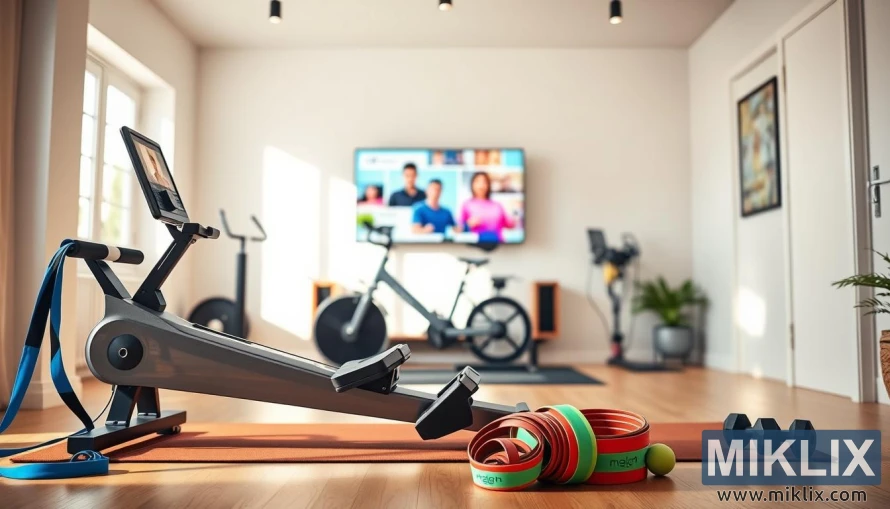How Rowing Improves Your Fitness, Strength, and Mental Health
Published: March 27, 2025 at 9:53:16 PM UTC
Last updated: March 28, 2025 at 3:16:22 PM UTC
Rowing is more than a water sport; it's a full-body workout that combines cardiovascular and strength training. Its unique movement offers numerous health benefits, leading to significant improvements in overall well-being. It enhances cardiovascular fitness and builds muscle strength, providing a holistic fitness approach for all. This article explores the health advantages of rowing, showing how it contributes to a healthier lifestyle.
Key Takeaways
- Engages 86% of a person's muscles, making it highly effective for a full-body workout.
- Low-impact nature of rowing is easy on the joints while delivering a solid cardiovascular workout.
- Improves posture, balance, and coordination by strengthening core and back muscles.
- Can significantly lower the risk of heart disease and improve cholesterol levels.
- Offers a meditative benefit, helping to reduce stress and enhance mood.
Rowing: A Total-Body Workout
Rowing is often viewed as an upper body exercise, but it's truly a total-body workout. The American Fitness Professionals Association states that 65–75% of the rowing stroke engages leg muscles. This targets key areas like the quadriceps, calves, and glutes. The remaining 25–35% focuses on the upper body, engaging muscles such as the pectorals, arms, and core. This holistic approach allows for strengthening and toning of multiple muscle groups at once.
For those looking to burn calories, rowing is highly effective. A 125-pound person can burn about 255 calories in a vigorous 30-minute session. Those weighing 155 and 185 pounds can burn around 369 and 440 calories, respectively. This makes rowing a top choice for a total-body workout and a significant calorie-burning activity. It surpasses ellipticals, which require less effort from the upper body and core.
The rowing motion deeply engages muscles across the entire body, greatly benefiting cardiovascular health. It combines endurance training with high-intensity moments, allowing the heart to adapt and strengthen. This dynamic mix enhances blood volume and the heart's structural integrity, providing unique cardiovascular benefits.
Rowing is one of the most efficient total-body workouts, engaging about 86% of the body's muscles. The motion improves heart health and fosters mental relaxation, making it accessible and enjoyable for all fitness levels. Whether you're a novice or a seasoned athlete, rowing's variety and effectiveness make it an ideal choice for a total-body workout.
Benefits for All Fitness Levels
Rowing offers significant advantages for people of all fitness levels, ensuring it's accessible and engaging for everyone. It's a beginner-friendly workout that can be adjusted to fit individual abilities. This means changing the resistance and pace to suit your needs. Its low-impact nature makes it great for those with joint issues or just starting out. It helps build strength and endurance. Plus, it improves muscle tone and burns calories efficiently, aiding in weight management.
Rowing workouts are perfect for those with tight schedules, as short sessions can be highly effective. High-intensity interval training (HIIT) on rowing machines maximizes calorie burn. This makes it a great choice for busy people.
Rowing's versatility makes it an excellent addition to any fitness routine. It's great for both beginners and those at advanced fitness levels. This creates a welcoming environment where everyone can succeed.
Low Impact Exercise
Rowing is a low impact exercise known for its smooth, rhythmic movements. It effectively minimizes stress on the joints. This makes rowing an excellent choice for those seeking a joint-friendly, safe workout that offers impressive results.
One of rowing's standout features is its ability to allow consistent workouts with less risk of joint pain or muscle soreness. Unlike high-impact exercises, rowing acts as a cross-training tool. It helps prevent injuries and aids in recovery. This makes rowing a great option for those concerned about high-impact activities.
Rowing's versatility allows it to be used for high-intensity interval training, endurance training, strength, and core workouts. For those aiming to maximize workout efficiency while minimizing impact, rowing is an exceptional solution. It enriches any fitness regimen, making it a top choice for a safe workout experience.
Meditative Effects of Rowing
Rowing is a meditative exercise that uses rhythmic movements to connect the mind and body deeply. Studies show it has a calming effect, more so when done outdoors. It combines mental clarity with physical activity, creating a unique state of focus and relaxation.
Rowing sessions that include mindfulness techniques, like a 6-week program for competitive rowers, show significant benefits. These include improved flow and reduced anxiety. Mindful breathing and centering exercises help rowers link their physical movements to their mental state. This intensifies stress relief and enhances overall well-being.
Rowing releases endorphins, boosting mood and reducing stress. Its repetitive nature can induce a meditative state, leading to better mental health and emotional resilience. By adding mindful practices to rowing, individuals can become more aware and better handle daily stress, improving their quality of life.
Heart and Lung Health
Rowing offers numerous benefits for heart health and lung capacity. It is an aerobic exercise that strengthens the heart muscle, boosting circulation. Studies show rowing enhances cardiorespiratory fitness, with a notable increase in peak oxygen uptake over 12 weeks, highlighting its effectiveness in improving aerobic capacity.
Rowing's benefits extend beyond the heart. It also improves vascular health, with brachial artery diameter increasing significantly after training. This shows rowing enhances cardiovascular health, lowering risks of hypertension, diabetes, and heart disease.
Rowing also boosts lung capacity. The exercise trains the body to use oxygen more efficiently, improving oxygen delivery to muscles. Strengthening the core and back during rowing supports better posture, which enhances breathing and lung function.
Efficiency of Rowing Workouts
Rowing is a standout for its efficiency, engaging multiple muscle groups at once. It works the quadriceps, hamstrings, glutes, shoulders, upper back, arms, and core. Using a rowing machine is an excellent way to build strength and boost cardiovascular health.
High-intensity interval training (HIIT) boosts the efficiency of rowing workouts. Structured pyramid workouts lead to quick fitness gains. For instance, a pyramid workout might involve 200-500 meters of effort followed by 1:30-3 minutes of rest. Time-based workouts can last from 1-4 minutes, with similar rest periods.
Choosing the right damper setting on rowing machines is key for efficiency. Beginners should start with settings of 3 to 5, ensuring smooth strokes without early muscle fatigue. Incorrect damper settings can make rowing too strenuous, hindering effective cardio training.
Proper form is essential for safe and effective rowing. A good stroke combines 60% leg drive, 20% core activation, and 20% arm pull. Deviating from this can lead to inefficiency and injury. To optimize performance, maintain a stroke ratio of 1:2, focusing on smooth, coordinated movements.
Adding rowing to your fitness routine can deliver impressive results, even with a busy schedule. Its blend of strength and cardio benefits makes it a favorite among fitness enthusiasts.
Alternative to Traditional Cardio Machines
Rowing machines stand out as a top choice for those looking for cardio alternatives beyond treadmills and stationary bikes. They offer a unique benefit by engaging both the upper and lower body, providing a well-rounded workout. Unlike treadmills, which mainly focus on the lower body, rowing machines work the entire body. This leads to better muscle development overall.
These machines support a variety of workout styles, including high-intensity interval training (HIIT). For example, you can row 250 meters at 70% effort followed by short rest periods. This approach caters to different fitness levels, making rowing a flexible option for various training routines.
Rowing also has advantages in indoor settings where space is limited. Many rowing machines are compact and foldable, saving space at home or in communal areas. Their quiet operation is a plus, unlike the noise of traditional gym machines. Studies show that combining rowing with weight training can boost fat loss, including visceral fat. This supports rowing as a powerful workout choice.
In conclusion, rowing combines cardiovascular health benefits with full-body muscle engagement. It's an excellent alternative to traditional cardio machines for those seeking dynamic and efficient fitness options.
Home Workout Convenience
Rowing machines are perfect for home workouts, ideal for those wanting a home gym. Many models are foldable and take up little space, making them great for small areas. This makes it easy to stay fit without needing a big gym.
There are many places in the home where these machines can fit well. Here are some ideas:
- Garage: Great for those with extra room, as it keeps noise away from living areas and can hold more gym gear.
- Spare Room/Office: Perfect for unused spaces, but you need to think about the machine's size and noise.
- Living Room: Offers plenty of room, but you might get interrupted; it's also good for using existing TV and sound systems.
- Bedroom: Good for solo workouts, but you'll need a way to store it when not in use.
- Outdoors: Offers a unique workout, but you need to consider the weather and the surface.
Indoor rowing works 86% of the body, giving a full-body workout. It's low-impact, which is great for those with joint issues or who are new to exercise. Having a rowing machine at home is more convenient than gym memberships, even more so after the pandemic.
Health Benefits Supported by Research
Scientific studies reveal the vast health advantages of rowing as a workout. A key study found that rowing three times a week for eight weeks boosted joint strength by 30%. This improvement was seen in elbows, shoulders, knees, and the lumbar area. It proves rowing enhances cardiovascular health and increases physical strength.
Further research shows a significant drop in body fat and LDL cholesterol after six weeks of rowing. Participants rowed for 40 minutes, five days a week. This indicates rowing is a powerful tool for managing weight.
Rowing's effectiveness as a total-body workout is evident. It engages 65-75% of leg muscles and 25-35% of upper body muscles. This makes it a balanced fitness routine. Rowing burns calories similar to other cardio machines, with 210-294 calories burned in 30 minutes at moderate intensity. At vigorous intensity, it burns 255-440 calories.
Rowing combines strength training with aerobic benefits. It improves cardiovascular fitness and strengthens the upper back, shoulders, biceps, triceps, and chest. The exercise also boosts MET values in walking and vigorous activities, showing its wide-ranging physical benefits.
Rowing also enhances mental health, with improvements in vitality and social function. It reduces bodily pain and boosts overall physical condition. These findings highlight rowing's value as a beneficial exercise backed by scientific research.
Rowing and Weight Management
Rowing stands out as a top choice for managing weight and reducing body fat. It engages up to 86% of the body's muscles, leading to substantial calorie burn and muscle building. For those looking to lose weight, adding rowing to their workout routine can lead to impressive results. This is true when combined with a balanced diet.
Correct posture and strong leg drives are key when rowing. These methods boost muscle engagement and calorie burn. Rowing machines offer a full-body workout, burning calories efficiently while protecting joints. Adding interval training increases calorie burn. Switching between different stroke rates during rowing not only aids in fat loss but also keeps the body challenged.
Studies show a 155 lb (70 kg) person can burn about 123 calories in 15 minutes of moderate rowing. Intense rowing can burn up to 185 calories in the same time frame. This calorie burn is similar to running, where a 175 lb (79 kg) person burns around 555 calories per hour at a moderate pace. Both activities are effective for burning calories, making rowing a strong option for weight loss.
Rowing also helps mobilize fats in the body, using them as energy. Pairing rowing with a diet rich in nutrients and high in protein can enhance weight loss. A varied rowing workout routine keeps calorie burn consistent, supporting long-term weight management goals.
Conclusion
Rowing stands out as a versatile and effective workout, benefiting individuals at all fitness levels. It engages up to 86% of the body's muscles, toning and burning calories at a rate of 400 to 800 per hour. This makes rowing a top choice for those aiming to shed pounds and boost fitness.
Regular rowing also boosts cardiovascular health, increasing heart volume and lowering resting heart rates. It's ideal for improving heart health, accommodating various fitness levels and health conditions. This is why rowing is so valuable for those seeking to enhance their cardiovascular performance.
Adding rowing to your weekly routine can significantly improve both mental and physical health. It offers a calming rhythm for stress relief and fosters social connections within rowing communities. This full-body workout is a game-changer for overall well-being.
Physical Exercise Disclaimer
This page contains information on one or more forms of physical exercise. Many countries have official recommendations for physical activity that should take precedence over anything you read here. You should never disregard professional advice because of something you read on this website.
Furthermore, the information presented on this page is for informational purposes only. While the author has put reasonable effort into verifying the validity of the information and researching the topics covered here, he or she is possibly not a trained professional with a formal education on the subject matter. Engaging in physical exercise may come with health risks in case of known or unknown medical conditions. You should always consult with your physician or another professional health care provider or professional trainer before making significant changes to your exercise regimen, or if you have any related concerns.
Medical Disclaimer
All content on this website is for informational purposes only and is not intended to be a substitute for professional advice, medical diagnosis, or treatment. None of the information here should be considered medical advice. You are responsible for your own medical care, treatment, and decisions. Always seek the advice of your physician or another qualified healthcare provider with any questions you may have regarding a medical condition or concerns about one. Never disregard professional medical advice or delay seeking it because of something you have read on this website.



